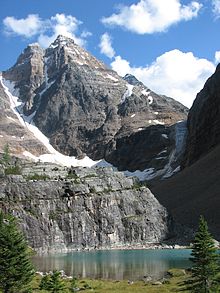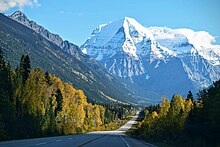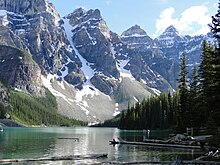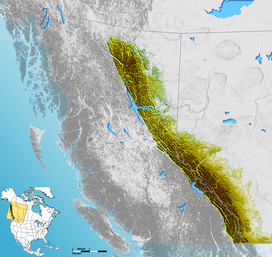Canadian Rockies
This articleneeds additional citations forverification.(January 2011) |
| Canadian Rockies | |
|---|---|
| Rocheuses canadiennes (French) | |
 | |
| Highest point | |
| Peak | Mount Robson |
| Elevation | 3,954 m (12,972 ft) |
| Coordinates | 53°06′38″N119°09′21″W/ 53.11056°N 119.15583°W |
| Dimensions | |
| Length | 1,460 km (910 mi)[1] |
| Width | 180 km (110 mi)[1] |
| Area | 194,000 km2(75,000 sq mi)[1] |
| Geography | |
| Country | Canada |
| Provinces | British ColumbiaandAlberta |
| Parent range | Pacific Cordillera |
| Geology | |
| Orogeny | Sevier orogeny[2] |
| Type of rock | Sedimentary rock |

TheCanadian Rockies(French:Rocheuses canadiennes) orCanadian Rocky Mountains,comprising both theAlberta Rockiesand theBritish ColumbianRockies, is theCanadiansegment of theNorth AmericanRocky Mountains.It is the easternmost part of theCanadian Cordillera,which is the northern segment of theNorth American Cordillera,the expansive system of interconnected mountain ranges between theInterior Plainsand thePacific Coastthat runs northwest–southeast fromcentralAlaskato theIsthmus of TehuantepecinMexico.
Canada officially defines the Rocky Mountains system as themountain chainseast of theRocky Mountain Trenchextending from theLiard Rivervalley in northern British Columbia to theAlbuquerque BasininNew Mexico,not including theMackenzie,RichardsonandBritish Mountains/Brooks RangeinYukonand Alaska (which are all included as the "Arctic Rockies" in theUnited States' definition of the Rocky Mountains system).[3]The Canadian Rockies, being the northern segment of this chain, is thus defined as comprising the central-eastern section of the North American Cordillera, between thePrairiesofAlbertaand theLiard Plainof northeastern British Columbia to the east and theInterior Mountains/PlateauandColumbia Mountainsto the west. It is divided into theNorthern Rockies(which is further subdivided into theMuskwaandHart Ranges) andContinental Ranges,separated by theMcGregor Rivervalley, theMcGregor Passand theKakwa Rivervalley.
The southern end of the Canadian Rockies extends into theU.S. stateofMontanaat various sites such as theWilson Range,Upper Waterton Lake,Boundary Creek,Cameron Lake,Forum Peak,Long Knife Peak,North Fork Flathead RiverandFrozen Lake.In geographic terms, the boundary is at theCanada–United States borderon49th parallel north,but in geological terms it might be considered to be atMarias Passin northern Montana.
The Canadian Rockies have numerous high peaks and ranges, such asMount Robson(3,954 metres; 12,972 feet) andMount Columbia(3,747 m; 12,293 ft). The Canadian Rockies are composed ofshaleandlimestone.Much of the range is protected by national and provincial parks, several of which collectively comprise aWorld Heritage Site.
Geography[edit]
The Canadian Rockies are the easternmost part of theCanadian Cordillera,the collective name for the mountains ofWestern Canada.They form part of theAmerican Cordillera,an essentially continuous sequence of mountain ranges that runs all the way fromAlaskato the very tip of South America. The Cordillera, in turn, is the eastern part of thePacific Ring of Firethat runs all the way around thePacific Ocean.

The Canadian Rockies are bounded on the east by the Canadian Prairies, on the west by the Rocky Mountain Trench, and on the north by the Liard River. Contrary to popular misconception, the Rockies do not extend north intoYukonor Alaska, or west into central British Columbia. North of the Liard River, theMackenzie Mountains,which are a distinct mountain range, form a portion of the border between the Yukon and theNorthwest Territories.The mountain ranges to the west of the Rocky Mountain Trench in southern British Columbia are called theColumbia Mountains,and are not considered to be part of the Rockies by Canadian geologists.[1]
Highest peaks[edit]

Mount Robson(3,954 metres; 12,972 feet) is the highest peak in the Canadian Rockies, but not the highest in British Columbia, since there are some higher mountains in theCoast MountainsandSaint Elias Mountains.Mount Robson lies on thecontinental dividenearYellowhead Pass,one of the lowest passes in the Canadian Rockies, and is close to theYellowhead Highway.Its base is 985 m (3,232 ft) above sea level, with a total vertical relief of 2,969 m (9,741 ft).
Mount Columbia (3,747 m; 12,293 ft) is the second-highest peak in the Canadian Rockies, and is the highest mountain in Alberta.
Snow Dome (3,456 m; 11,339 ft) is one of twohydrological apexesof North America. Water flows off Snow Dome into three different watersheds, into the Pacific Ocean,Arctic Ocean,andAtlantic OceanviaHudson Bay.[4]
The Canadian Rockies are not the highest mountain ranges in Canada. Both the Saint Elias Mountains (highest point in CanadaMount Loganat 5,959 m; 19,551 ft) and the Coast Mountains (highest pointMount Waddingtonat 4,016 m; 13,176 ft) have higher summits.
Mountain ranges[edit]
The Canadian Rockies are subdivided into numerousmountain ranges,structured in two main groupings, theContinental Ranges,which has three main subdivisions, theFront Range,Park RangesandKootenay Ranges,and theNorthern Rockieswhich comprise two main groupings, theHart Rangesand theMuskwa Ranges.The division-point of the two main groupings is atMonkman Passnorthwest of Mount Robson and to the southwest ofMount Ovington.
Rivers[edit]
The Canadian Rockies are noted for being the source of several major river systems, and also for the many rivers within the range itself. The Rockies form thedividebetween the Pacific Ocean drainage on the west and that of Hudson Bay and the Arctic Ocean on the east. Of the range's rivers, only thePeace Riverpenetrates the range. Notable rivers originating in the Canadian Rockies include theFraser,Columbia,North Saskatchewan,BowandAthabasca Rivers.
Geology[edit]

The Canadian Rockies are quite different in appearance and geology from the American Rockies to the south of them. The Canadian Rockies are composed of layeredsedimentary rocksuch aslimestoneandshale,whereas the American Rockies are made mostly ofmetamorphicandigneous rocksuch asgneissandgranite.
The Canadian Rockies are overall more jagged than the American Rockies, because the Canadian Rockies have been more heavilyglaciated,resulting in sharply pointed mountains separated by wide, U-shaped valleysgougedby glaciers, whereas the American Rockies are overall more rounded, with river-carved V-shaped valleys between them. The Canadian Rockies are cooler and wetter, giving them moister soil, bigger rivers, and more glaciers. Thetree lineis much lower in the Canadian Rockies than in the American Rockies.
Parks[edit]


Five national parks are located within the Canadian Rockies, four of which are adjacent and make up theCanadian Rocky Mountain Parks.These four parks areBanff,Jasper,KootenayandYoho.The fifth national park,Waterton Lakes,is not adjacent to the others. Waterton Lakes lies farther south, straddling theCanada–US borderas the Canadian part of theWaterton-Glacier International Peace Park.The four adjacent parks, combined with three British Columbia provincial parks, were declared a singleUNESCOWorld Heritage Site in 1984[5]for the unique mountain landscapes found there.
Numerous provincial parks are located in the Canadian Rockies, includingHamber,Mount AssiniboineandMount Robsonparks.
Throughout the Rockies, and especially in the national parks, theAlpine Club of Canadamaintains a series of alpine huts for use by mountaineers and adventurers.[6]
Human history[edit]
The Rockies and the Canadian Pacific Railway[edit]
TheCanadian Pacific Railwaywas founded to provide a link from the province of British Columbia to the eastern provinces. The main difficulty in providing such a link were the Rockies themselves: treacherous mountain passes, fast rivers and sheer drops made for a difficult railway construction process. The following articles describe in detail the political and technical feats involved:
See also[edit]
- Ecology of the Rocky Mountains
- Geology of the Rocky Mountains
- Arctic Cordillera:an example of another major mountain system in North America east of the Canadian Rockies.
- The Rocky Mountain Rangers
References[edit]
- ^abcdGadd, Ben (1995).Handbook of the Canadian Rockies(2nd ed.). Corax Press.ISBN978-0-9692631-1-1.
- ^"Laramide and Sevier orogenies (PLATE TECTONICS) – g17"(PDF).geowords.com.p. 423.Archived(PDF)from the original on 2020-10-08.Retrieved2017-08-20.
- ^Madole, Richard F.; Bradley, William C.; Loewenherz, Deborah S.; Ritter, Dale F.; Rutter, Nathaniel W.; Thorn, Colin E. (1987)."Rocky Mountains".In Graf, William L. (ed.).Geomorphic Systems of North America.Decade of North American Geology. Vol. 2 (Centennial Special ed.).Geological Society of America(published 1987-01-01). pp. 211–257.doi:10.1130/DNAG-CENT-v2.211.ISBN9780813754147.Retrieved2021-06-22.
- ^Jennings, Ken (7 October 2013)."The Canadian Mountain Peak that Feeds Three Different Oceans".Conde Nast Traveler.Archivedfrom the original on 2020-03-03.Retrieved3 March2020.
- ^"Canadian Rocky Mountain Parks".World Heritage List.UNESCO.Archivedfrom the original on 2020-10-08.Retrieved2010-01-01.
- ^"ACC Huts".Alpine Club of Canada.Retrieved2022-05-23.
Further reading[edit]
- Adams, Ansel (2013).Ansel Adams In The Canadian Rockies.Little, Brown and Company.ISBN978-0-316-24341-4.
- Koller, Brenda (2006).The Canadian Rockies Adventure Guide.Hunter Publishing Inc.ISBN978-1-58843-573-6.(restricted online version (Google Books))
- "Canadian Rockies".Encyclopædia Britannica(Online ed.). 2009.RetrievedAugust 22,2009.
External links[edit]
- Canadian Rockies,NASA Earth ObservatoryPOTD, April 23, 2023.

